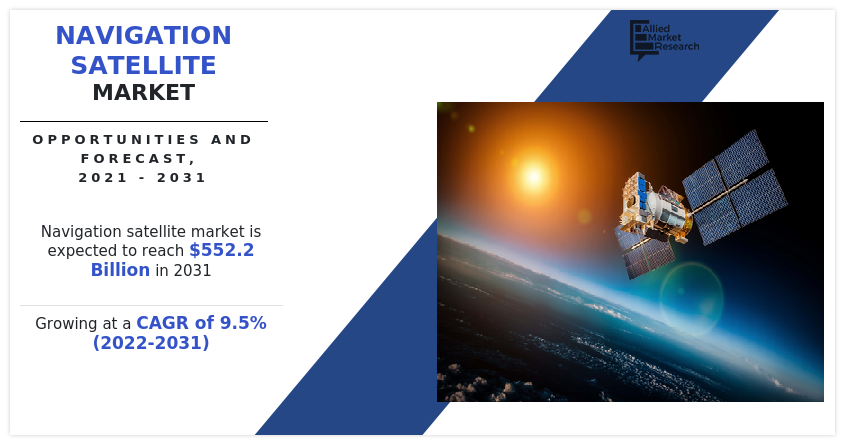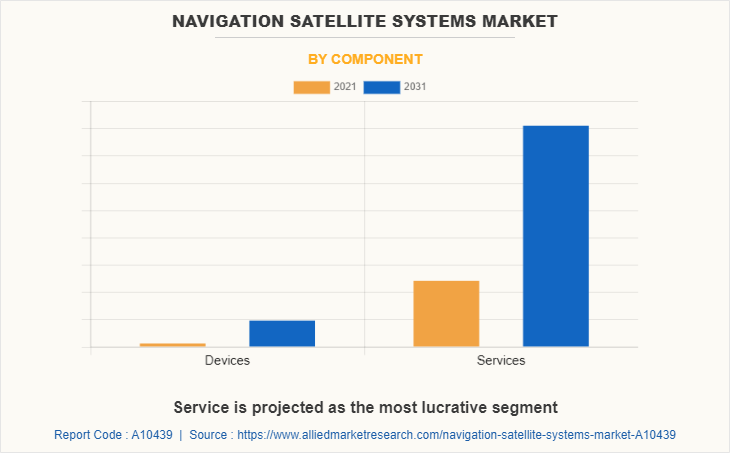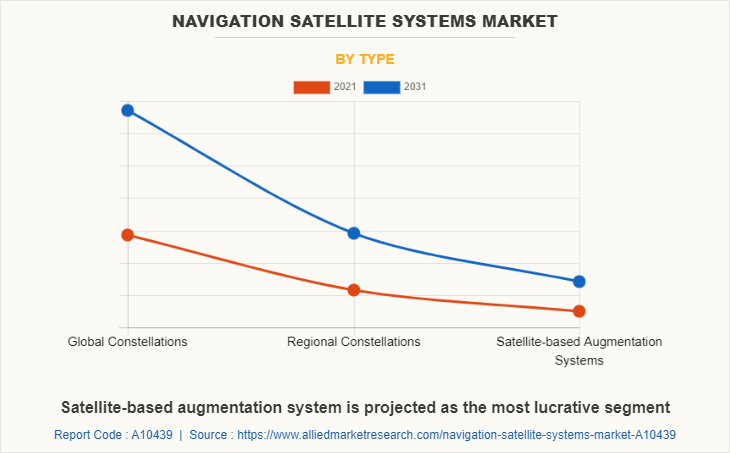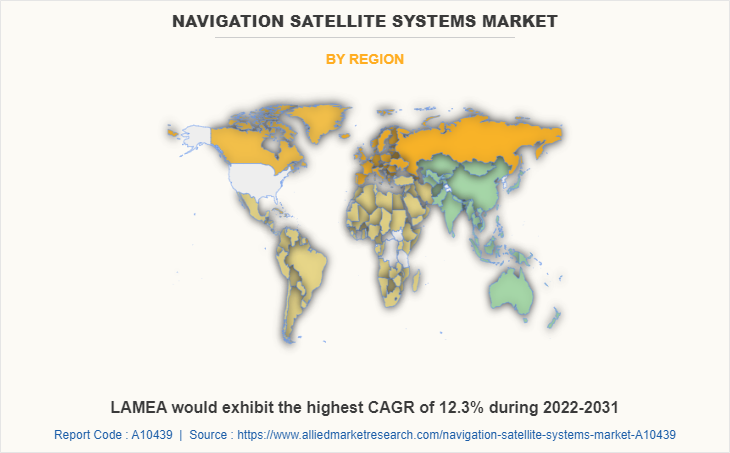Navigation Satellite Systems Market Research, 2031
The global navigation satellite systems market size was valued at $225.30 billion in 2021, and is projected to reach $552.20 billion by 2031, growing at a CAGR of 9.5% from 2022 to 2031. Global navigation satellite system (GNSS) refers to a constellation of satellites, which provides signals from the space that relays positioning, navigation, and timing data to the GNSS receiver. It provides accurate real-time positioning and timing services to users across the globe. GNSS comprises satellite navigation systems which includes GPS, GLONASS, Beidou, and Galileo. At present, there are three fully functional GNSS systems operating across the globe. First is U.S. Global Positioning System (NAVSTAR), second is Global Orbiting Navigation Satellite System (GLONASS) by Russian Federation, and third is European Union’s Galileo. Moreover, it has several applications including road & rail navigation, location-based services, maritime navigation, agriculture, and others.

The growth of the global navigation satellite systems market has propelled due to increase in the adoption of autonomous vehicles for several applications and growth in dependence on location-based services. However, cyber-attacks impacting navigation satellite systems and inaccuracy in GNSS data are the factors that hamper the growth of the GNSS market. Furthermore, fusion of 5G and GNSS is expected to offer growth opportunities during the forecast period.
The navigation satellite systems market is segmented on the basis of type, component, application, and region. By type, it is segmented into global constellations, regional constellations, and satellite-based augmentations. By component, it is classified into devices and services. By devices, it is further bifurcated into smartphones, mobiles & PDAs, personal tracking devices, sport & wearables, and other devices. By services, it is further bifurcated into added-value services and augmentation services. By application, the global navigation satellite systems market is segmented into consumer and health solutions, road & automotive, and others.
Based on consumer and health solutions, it is further bifurcated into navigation & tracking, health & lifestyle, and tourism & corporate. By road & automotive, it is further fragmented into personal navigation device, road user charging, public transport buses, in-vehicle system, road fleet management, connected & automated driving, and others. On the basis of others, it is further classified into aviation & drones, agriculture, maritime & inland waterways, infrastructure, and others. By region, the report is analyzed across North America, Europe, Asia-Pacific, and LAMEA.

Some leading companies profiled in the global navigation satellite industry report comprises Broadcom Inc., Furuno Electric Co., Ltd., Garmin Ltd., Hexagon AB, L3Harris Technologies, Inc., Laired Connectivity, Navtech GPS, Qualcomm Technologies, Inc., Raytheon Technologies Corporation, SkyTraq Technology, Inc., STMicroelectronics N.V., Texas Instruments Incorporated, Topcon Corporation, Trimble Inc., and UniStrong (Hemispere GNSS).
Increase in the adoption of autonomous vehicles for several applications
An autonomous vehicle, referred as driverless vehicle, is a vehicle capable of sensing its environment and operates without human intervention. Autonomous vehicle rely on advanced artificial intelligence and machine learning systems to understand their surrounding environment. The advent of autonomous vehicle is one of the three revolutions that is bringing changes across the globe. The other two revolutions are transition from internal combustion engine to electric and integration of cars into digital traffic networks.
In recent years, adoption of autonomous vehicles such as unmanned aerial vehicles, underwater vehicles and unmanned ground vehicles have increased across the globe. The autonomous vehicles require integration of navigation satellite system receivers to determine real-time positioning information, which further is utilized in several applications such as surveying, military missions, mapping, and autonomous delivery.
Moreover, autonomous vehicle with the aid of GNSS receivers can perform effectively even in a low navigation satellite signal reception area. Therefore, demand for GNSS integrated autonomous vehicles is increased. Thus, increase in the adoption of autonomous vehicles for several applications is one of the factors that drive the growth of the navigation satellite system industry during the forecast period.

Growth in dependence on location-based services
Location-based services (LBSs) are a set of services that use real time geo-data through internet capable devices to provide information about current location. LBSs are greatly dependent on geographical mapping, which is carried out with the help of satellite imagery received through navigation satellites.
LBSs help during flood, rescue events, natural calamities, and for weather forecasting to develop future programs to simplify the situational events. Therefore, most of the countries mandate the use of LBSs as they help in decision making for civil defense operations.
In addition, people are using LBSs through various internet capable devices such as smartphones, tracking devices, digital cameras, tablets, and fitness devices. Increase in adoption of smartphones across the globe accelerates the utilization of location-based services; thereby, boosting the navigation satellite system industry growth. Moreover, various mobile applications such as business and communication apps, gaming apps, health & wellness apps, and personal convenience apps majorly use real-time positioning information. Thus, upsurge in trend of navigation and location-based services across various sectors are expected to drive the growth of the navigation satellite systems market.
The navigation satellite systems market is segmented into Component, Type and Application.

Key Benefits For Stakeholders
- This report provides a quantitative analysis of the market segments, current trends, estimations, and dynamics of the navigation satellite industry analysis from 2021 to 2031 to identify the prevailing navigation satellite market opportunities.
- The market research is offered along with information related to key drivers, restraints, and opportunities.
- Porter's five forces analysis highlights the potency of buyers and suppliers to enable stakeholders make profit-oriented business decisions and strengthen their supplier-buyer network.
- In-depth analysis of the navigation satellite systems market segment assists to determine the prevailing market opportunities.
- Major countries in each region are mapped according to their revenue contribution to the global market.
- Market player positioning facilitates benchmarking and provides a clear understanding of the present position of the market players.
- The report includes the analysis of the regional as well as global navigation satellite systems market trends, key players, market segments, application areas, and market growth strategies.
Navigation Satellite Systems Market Report Highlights
| Aspects | Details |
| By Component |
|
| By Type |
|
| By Application |
|
| By Region |
|
| Key Market Players | STMicroelectronics, Texas Instruments, Raytheon Technologies Corp., Hemisphere GNSS, Laird Plc, Navtech GPS, Topcon Corporation, Hexagon, Furuno Electric, Garmin Ltd, L3 Harris Corporation, Broadcom Inc., Trimble Inc., Qualcomm Inc, SkyTraq Technology, Inc. |
Analyst Review
In recent years, adoption of smartphones along with smart wearable, and other consumer electronics has increased at a very high rate across the globe. Smartphones have several features along with navigation technology for mapping, geo-marketing, and navigation applications. This increased adoption of smartphones has accelerated the adoption of several location-based services. However, for effective working of location-based services, high speed network is required. The fusion of 5G technology with GNSS can aid in effective working of locations-based services in smartphones for mapping and navigation applications.
GNSS-enabled consumer solutions comprises a multitude of applications to satisfy different usage conditions and needs. These applications are supported by several categories of connected devices such as smartphones and tablets, personal tracking devices, wearables, digital cameras and portable computers. COVID-19 have changed patterns of exercise for sports enthusiasts. It has renewed interest in personal health and wellbeing. It has resulted in increase in uptake of fitness tracking apps and wearables as people are focusing on their personal health. In addition, fitness apps and wearables manufacturers are providing enhanced functions with the help of GNSS and augmented reality to improve user experience. For instance, Google Live AR Navigation combines GNSS localization and visual mapping providing floating arrows on your camera feed, making it easier to follow directions or find a way out of unfamiliar areas whilst out on a run.
The global navigation satellite system market was valued at $225.3 billion in 2021 and is projected to reach $552.2 billion in 2031.
Asia-Pacific is the largest regional market for global navigation satellite system.
Consumer and health solutions is the leading application of global navigation satellite system market.
Some leading companies in the market include Broadcom Inc., Garmin Ltd., Hexagon AB, L3Harris Technologies, Inc., Qualcomm Technologies, Inc., and Raytheon Technologies Corporation among others.
The upcoming trends in the global navigation satellite system market include greater adoption in aviation and drone, agriculture, & infrastructure applications, and increased use in development of autonomous solutions.
Loading Table Of Content...


